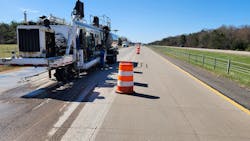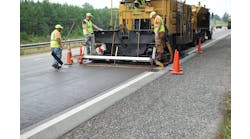By Kristin Dispenza, Contributing Author
Across the country, departments of transportation are innovating—successfully—with new rehabilitation methods. It’s imperative to identify ways of preserving and maintaining the new pavement types once they are in place.
In 2009, the Minnesota Department of Transportation (MnDOT) employed a new rehabilitation method on a 7-mile, four-lane stretch of Interstate 35 where existing asphalt showed major deterioration. The new method was a 6-inch-thick, 24-foot-wide concrete overlay, jointed in a 6-foot-by-6-foot pattern.
This was MnDOT’s first large-scale project using a thin concrete overlay on an interstate roadway. The project was a success, and it provided 14 years of service before pavement preservation and diamond grinding were required for rehabilitation.
In 2023, minimal full depth repairs and diamond grinding of 184,000 square yards of pavement were performed, reducing International Roughness Index (IRI) measurements from 90 in the northbound lane and 100 in the southbound lane to 30 in the northbound lane and the mid-30s in the southbound lane.
The process provides a good example of how concrete pavement preservation ensures continued optimization of “new” rehabilitation treatments.
Thin Concrete Overlay
A concrete overlay can be used on existing concrete, asphalt or composite pavements. When an overlay is less than or equal to 6-inches thick, it is generally referred to as a “thin” overlay.
The 6-foot-by-6-foot joint spacing used on I-35 is typical for thin overlays, which have a closer joint spacing than traditional pavement.
Thin overlays can be bonded or unbonded to the underlying pavement. In unbonded conditions, some degree of movement between the overlay and existing pavement may be designed in or an interface layer may be placed between the existing pavement and the overlay.
Bonded solutions utilize the underlying layer to share stresses with the concrete overlay and are better suited to applications where the underlying pavement is in reasonable condition prior to the overlay.
Properly constructed, a concrete overlay will deliver the durability and excellent ride quality associated with concrete construction. However, to function optimally during its service life, road owners must thoroughly evaluate the structural integrity of existing pavement prior to commencement of a project.
During the design phase, careful consideration must be given to the various options for overlay thickness, panel dimensions and bonding conditions. Once an overlay is in place, it should be regularly inspected and maintained to fully reap the benefits of its longevity.
While concrete pavements typically only require maintenance every 10-15 years, it is important to address areas of distress in a timely fashion.
Concrete pavement preservation (CPP) techniques (which include full- and partial-depth repair, dowel bar retrofit, slab stabilization, cross or slot stitching, joint resealing, and diamond grinding) were developed more than 60 years ago to rehabilitate concrete pavement.
Distresses, such as faulting or roughness in a concrete overlay, can be repaired using the same patching and diamond grinding techniques that work for traditional concrete pavement.
The I-35 Overlay
The 2009 overlay project on I-35 was located about 40 miles north of the Twin Cities, between North Branch and Harris, Minn. Average daily traffic (ADT) was 28,000 with 6.2% truck traffic.
The road was originally constructed of 8-inch bituminous pavement in 1969. A bituminous overlay had been placed in 1987, and by 1991 maintenance efforts began to address cracking.
With asphalt cracking becoming extreme, MnDOT began looking at out-of-the-box solutions. Successful testing of a 6-inch-thick concrete overlay at the Minnesota Road Research Facility (MnROAD) caught the attention of MnDOT engineers and encouraged them to try concrete (as opposed to milling and thick asphalt overlays) on I-35.
“The MnROAD test section performed well with much heavier traffic loads than I-35 would see,” said Dave Van Deusen, metro district materials/pavement engineer, MnDOT.
MnDOT used life cycle cost analysis to compare a 6-inch asphalt overlay to a 6-inch concrete overlay, and concrete was selected.
Mainline pavement and inside shoulders received a 4-inch mill, while the outside shoulders received a 2-inch mill. MnDOT placed and sawed 195,000 square yards of Portland cement concrete (PCC) into 6-by-6-foot panels on the 24-foot-wide mainline.
The 1/8-inch saw cuts were filled with hot pour sealant, and tie bars were used at longitudinal joints; 6 inches of bituminous mix were placed on the inside shoulder and 4 inches on the outside shoulder.
The I-35 CPP
Van Deusen said that ride quality had suffered on I-35 in recent years, and MnDOT received inquiries from the public about when it would improve.
“Furthermore, some panels had cracked, and we felt they should be repaired,” he said.
On interstates, MnDOT aims to maintain the ride quality index (RQI) above a value of 3.1 (the IRI being equal to 100 inches/mile). MnDOT 2022 Pavement Management data results showed RQI values of 3.2 (northbound) and 2.8 (southbound).
As a result, in 2023, MnDOT contracted PCiRoads to perform a small number of full-depth repairs on the overlaid section of I-35. Subcontractor Diamond Surface, Inc. performed 184,000 square yards of diamond grinding.
The work was performed with minimal traffic disruption, closing single lanes for 12 hours a day and reopening roads fully each night. Grinding cost $881,733 and took two weeks on the highway's northbound side, plus two weeks on the southbound side.
“There can be a real benefit to diamond grinding a pavement before its IRI measurements become too high,” said Matthew J. Zeller, former executive director, Concrete Paving Association of Minnesota. “When IRI values are over 90 inches per mile, decreasing roughness through diamond grinding offers a real opportunity to reduce vehicle impact loading and therefore minimize further pavement damage.”
Van Deusen said the concrete overlay has performed well and is structurally sound.
“It was apparent that a minor rehabilitation could preserve the pavement,” he said. “The selected approach improved the ride, preserved the structure and conserved resources by only needing to grind off a fraction of an inch.” RB
Kristin Dispenza is an account manager at Advancing Organizational Excellence.



